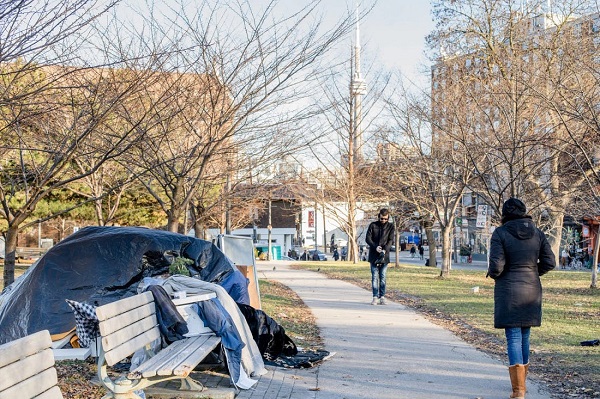Addictions
Governments ease alcohol access as evidence of its harms mount

By Alexandra Keeler
From cancer to heart disease to brain damage, the evidence of alcohol’s harms is mounting. So why are governments making it easier to drink?
In May, shortly after Parliament resumed, Quebec Senator Patrick Brazeau introduced Bill S-202, a private member’s bill to require nearly all alcoholic beverages to carry health warning labels.
“As a former alcohol consumer, I was once in the 75 per cent of Canadians who are not aware that there is a causal link between alcohol consumption and seven cancers,” Brazeau told the House of Commons on June 3.
“I personally battled colon cancer several years ago, so much so that when I received treatment, I felt I was being killed inside.”
Brazeau is something of an outlier in government. Public health experts say Canadian governments are not doing enough to address alcohol’s known health risks — and that the alcohol industry is a big part of the problem.
“We’ve known about the carcinogenic effects of alcohol since the 80s,” said Peter Butt, a University of Saskatchewan researcher and co-chair of Canada’s latest drinking guidelines. “But there are no warning labels, so the consumer is given false confidence.
“Some of this falls at the doorstep of the government, because they regulate the labeling.”
Alcohol harms
Today, the World Health Organization warns that alcohol harms nearly every system in the body.
The International Agency for Research on Cancer classifies alcohol as a cause of six cancers.
Chronic alcohol use raises the risks of liver and heart disease, brain damage, mental health issues, injuries and fetal alcohol spectrum disorders.
In Canada, the federal government oversees labeling and public health messaging rules, while the provinces control liquor sales and drinking ages.
In January 2023, Health Canada released updated national alcohol guidelines in response to the growing evidence of alcohol-related harms. This new guidance marked a major departure from its 2011 recommendations, which had suggested women not exceed 10 drinks per week and men not exceed 15.
The new guidelines have a sober message: no amount of alcohol is risk-free, and risk rises significantly with more than two drinks a week.
“We didn’t say you shouldn’t drink more than two standard drinks a week. We said you should reduce the amount that you drink,” said Butt, who co-chaired the team that updated the guidelines.
“The consumer had a right to know.”
Mixed messages
Aside from tightening its guidelines, Canadian governments have done little to better protect the public.
Public health experts say one major flashpoint has been warning labels. In general, drinks with greater than 0.5 per cent alcohol content are exempt from standard food and beverage labeling requirements.
“Even bottled water or non-alcoholic beer has to have the nutrition facts because it doesn’t have enough alcohol in it to get the exemption,” said Adam Sherk, a research scientist at the Canadian Centre for Substance Use and Addiction who also advised on Canada’s updated alcohol guidelines.
The Canadian Cancer Society has been advocating for labels on alcohol products since 2017. The Canadian Institute for Substance Use Research has done the same since 2023. But Health Canada has not initiated any regulatory process to mandate warning labels for alcohol products.
Some research indicates such labels could reduce sales.
A 2020 study by the Yukon government and the Canadian Institute for Substance Use Research tested how warning labels affect consumer behaviour. It found labels did increase awareness and reduce sales.
Yukon pulled its label requirements after the alcohol industry threatened to sue the government.

Convenient
Labelling is just one of many measures governments could take to reduce alcohol-related harm.
In addition to labels, the Canadian Alcohol Policy Evaluation project recommends minimum unit pricing, marketing and advertising controls, and public education campaigns. No province or territory has fully implemented all of these measures.
“[T]he Canadian federal government has not adopted or only partially adopted many evidence based alcohol policies,” the project’s report reads.
Meanwhile, some provinces are moving in the opposite direction.
Nova Scotia is considering expanding retail options. In April, Quebec rejected a recommendation to lower its blood alcohol limit for drivers, despite repeated coroner warnings.
Ontario has gone the furthest.
The province plans to invest $175 million over five years to grow its alcohol sector. It has begun permitting alcohol sales in convenience stores for the first time — with up to 8,500 new retailers expected to carry alcohol by 2026. It has also scrapped previous limits on pack sizes and discount pricing.
In April 2024, the province’s chief medical officer, Dr. Kieran Moore, recommended raising the legal drinking age from 19 to 21. Premier Doug Ford rejected the idea, arguing that if 18-year-olds can enlist in the military, they should be allowed to drink.
“We believe in treating people like adults,” he told media at the time.
In late June, the province also approved alcohol consumption on so-called “pedal pubs” — large, multi-person bicycles equipped with a U-shaped bar, often used for tours or bachelor parties.
“There’s never been such a large increase in availability all at once,” said Sherk, calling Ontario’s expansion “unprecedented.”
False profits
Tim Stockwell, a University of Victoria professor and former director of the Canadian Institute for Substance Use Research, says corporate influence helps explain why governments are failing to address alcohol’s health risks.
“Evidence for harms from alcohol has been with us for decades and has only strengthened,” said Stockwell. “Commercial vested interests have always dominated the policy sphere.”
Federal lobbying records show Beer Canada has routinely targeted Health Canada and more than two dozen federal agencies to influence policy on labeling, taxation and public health messaging. This includes closed-door meetings with MPs and senior officials from the Department of Finance and Agriculture Canada.
Beer Canada did not respond to multiple requests for comment by press time. Spirits Canada and Molson Coors Beverage Company also did not respond to multiple requests for comment.
Butt, of the University of Saskatchewan, says the money governments generate from alcohol sales creates a conflict with their public health mandate.
Federal and provincial governments generate revenue from alcohol through a range of mechanisms, including excise taxes, provincial markups, sales taxes and licensing fees. In some provinces, governments also earn profits from government-run liquor stores.
“[Governments] look at it from a lost revenue perspective, rather than from a public health perspective,” said Butt.
Ian Culbert, of Public Health Canada, puts it more bluntly. “Governments have a substance sales issue, as opposed to a substance use issue,” he said. “But it’s short-term gain for long-term pain.”
“Public Health wants to reduce consumption, because all consumption contributes to harm,” said Stockwell, of the Canadian Institute for Substance Use Research. “Commerce wants to … expand the consumption.”
A familiar playbook
Every expert interviewed for this story said the alcohol industry is following the tobacco industry’s playbook.
“They’re using the same sort of rear-guard action policies: denial, heavy government lobbying, government revenue,” said Butt.
“I don’t trust either the industry nor the government to do the right thing based upon past action. I think it’s important that consumers are educated.”
Adam Sherk agrees. “If I was [the industry], I would also be scared about consumers knowing this link [to cancer] better,” he said.
“The strategy is to obfuscate the link — point to studies that might be older or found no link, or put a lot of things in the water so it seems less clear than it is.”
But alcohol, experts say, is harder to regulate than tobacco. “Nobody liked to be in an airplane with smokers eating dinner next to smokers, so it was really easy to demonize smoking,” said Culbert.
“Alcohol is so ingrained in everything: we drink when we’re happy, we drink when we’re sad, we drink when we’re bored — we drink.”
Still, the normalization does not make the risks any less real. “There’s a mortality rate attached to this,” said Butt.
“And that’s the thing that is tragic — this is a modifiable risk factor.”
This article was produced through the Breaking Needles Fellowship Program, which provided a grant to Canadian Affairs, a digital media outlet, to fund journalism exploring addiction and crime in Canada. Articles produced through the Fellowship are co-published by Break The Needle and Canadian Affairs.
Our content is always free – but if you want to help us commission more high-quality journalism, consider getting a voluntary paid subscription.
Addictions
BC premier admits decriminalizing drugs was ‘not the right policy’

From LifeSiteNews
Premier David Eby acknowledged that British Columbia’s liberal policy on hard drugs ‘became was a permissive structure that … resulted in really unhappy consequences.’
The Premier of Canada’s most drug-permissive province admitted that allowing the decriminalization of hard drugs in British Columbia via a federal pilot program was a mistake.
Speaking at a luncheon organized by the Urban Development Institute last week in Vancouver, British Columbia, Premier David Eby said, “I was wrong … it was not the right policy.”
Eby said that allowing hard drug users not to be fined for possession was “not the right policy.
“What it became was a permissive structure that … resulted in really unhappy consequences,” he noted, as captured by Western Standard’s Jarryd Jäger.
LifeSiteNews reported that the British Columbia government decided to stop a so-called “safe supply” free drug program in light of a report revealing many of the hard drugs distributed via pharmacies were resold on the black market.
Last year, the Liberal government was forced to end a three-year drug decriminalizing experiment, the brainchild of former Prime Minister Justin Trudeau’s government, in British Columbia that allowed people to have small amounts of cocaine and other hard drugs. However, public complaints about social disorder went through the roof during the experiment.
This is not the first time that Eby has admitted he was wrong.
Trudeau’s loose drug initiatives were deemed such a disaster in British Columbia that Eby’s government asked Trudeau to re-criminalize narcotic use in public spaces, a request that was granted.
Records show that the Liberal government has spent approximately $820 million from 2017 to 2022 on its Canadian Drugs and Substances Strategy. However, even Canada’s own Department of Health in a 2023 report admitted that the Liberals’ drug program only had “minimal” results.
Official figures show that overdoses went up during the decriminalization trial, with 3,313 deaths over 15 months, compared with 2,843 in the same time frame before drugs were temporarily legalized.
Addictions
Canada must make public order a priority again

A Toronto park
Public disorder has cities crying out for help. The solution cannot simply be to expand our public institutions’ crisis services
[This editorial was originally published by Canadian Affairs and has been republished with permission]
This week, Canada’s largest public transit system, the Toronto Transit Commission, announced it would be stationing crisis worker teams directly on subway platforms to improve public safety.
Last week, Canada’s largest library, the Toronto Public Library, announced it would be increasing the number of branches that offer crisis and social support services. This builds on a 2023 pilot project between the library and Toronto’s Gerstein Crisis Centre to service people experiencing mental health, substance abuse and other issues.
The move “only made sense,” Amanda French, the manager of social development at Toronto Public Library, told CBC.
Does it, though?
Over the past decade, public institutions — our libraries, parks, transit systems, hospitals and city centres — have steadily increased the resources they devote to servicing the homeless, mentally ill and drug addicted. In many cases, this has come at the expense of serving the groups these spaces were intended to serve.
For some communities, it is all becoming too much.
Recently, some cities have taken the extraordinary step of calling states of emergency over the public disorder in their communities. This September, both Barrie, Ont. and Smithers, B.C. did so, citing the public disorder caused by open drug use, encampments, theft and violence.
In June, Williams Lake, B.C., did the same. It was planning to “bring in an 11 p.m. curfew and was exploring involuntary detention when the province directed an expert task force to enter the city,” The Globe and Mail reported last week.
These cries for help — which Canadian Affairs has also reported on in Toronto, Ottawa and Nanaimo — must be taken seriously. The solution cannot simply be more of the same — to further expand public institutions’ crisis services while neglecting their core purposes and clientele.
Canada must make public order a priority again.
Without public order, Canadians will increasingly cease to patronize the public institutions that make communities welcoming and vibrant. Businesses will increasingly close up shop in city centres. This will accelerate community decline, creating a vicious downward spiral.
We do not pretend to have the answers for how best to restore public order while also addressing the very real needs of individuals struggling with homelessness, mental illness and addiction.
But we can offer a few observations.
First, Canadians must be willing to critically examine our policies.
Harm-reduction policies — which correlate with the rise of public disorder — should be at the top of the list.
The aim of these policies is to reduce the harms associated with drug use, such as overdose or infection. They were intended to be introduced alongside investments in other social supports, such as recovery.
But unlike Portugal, which prioritized treatment alongside harm reduction, Canada failed to make these investments. For this and other reasons, many experts now say our harm-reduction policies are not working.
“Many of my addiction medicine colleagues have stopped prescribing ‘safe supply’ hydromorphone to their patients because of the high rates of diversion … and lack of efficacy in stabilizing the substance use disorder (sometimes worsening it),” Dr. Launette Rieb, a clinical associate professor at the University of British Columbia and addiction medicine specialist recently told Canadian Affairs.
Yet, despite such damning claims, some Canadians remain closed to the possibility that these policies may need to change. Worse, some foster a climate that penalizes dissent.
“Many doctors who initially supported ‘safe supply’ no longer provide it but do not wish to talk about it publicly for fear of reprisals,” Rieb said.
Second, Canadians must look abroad — well beyond the United States — for policy alternatives.
As The Globe and Mail reported in August, Canada and the U.S. have been far harder hit by the drug crisis than European countries.
The article points to a host of potential factors, spanning everything from doctors’ prescribing practices to drug trade flows to drug laws and enforcement.
For example, unlike Canada, most of Europe has not legalized cannabis, the article says. European countries also enforce their drug laws more rigorously.
“According to the UN, Europe arrests, prosecutes and convicts people for drug-related offences at a much higher rate than that of the Americas,” it says.
Addiction treatment rates also vary.
“According to the latest data from the UN, 28 per cent of people with drug use disorders in Europe received treatment. In contrast, only 9 per cent of those with drug use disorders in the Americas received treatment.”
And then there is harm reduction. No other country went “whole hog” on harm reduction the way Canada did, one professor told The Globe.
If we want public order, we should look to the countries that are orderly and identify what makes them different — in a good way.
There is no shame in copying good policies. There should be shame in sticking with failed ones due to ideology.
Our content is always free – but if you want to help us commission more high-quality journalism,
consider getting a voluntary paid subscription.
-

 MAiD20 hours ago
MAiD20 hours agoDisabled Canadians increasingly under pressure to opt for euthanasia during routine doctor visits
-

 Alberta22 hours ago
Alberta22 hours agoPetition threatens independent school funding in Alberta
-

 Alberta2 days ago
Alberta2 days agoBusting five myths about the Alberta oil sands
-

 Courageous Discourse2 days ago
Courageous Discourse2 days agoNo Exit Wound – EITHER there was a very public “miracle” OR Charlie Kirk’s murder is not as it appears
-

 Business21 hours ago
Business21 hours agoCanada Revenue Agency found a way to hit “Worse Than Rock Bottom”
-

 Energy2 days ago
Energy2 days agoMinus Forty and the Myth of Easy Energy
-

 Health2 days ago
Health2 days agoNew report warns WHO health rules erode Canada’s democracy and Charter rights
-

 Digital ID19 hours ago
Digital ID19 hours agoToronto airport requests approval of ‘digital IDs’ for domestic airport travel



